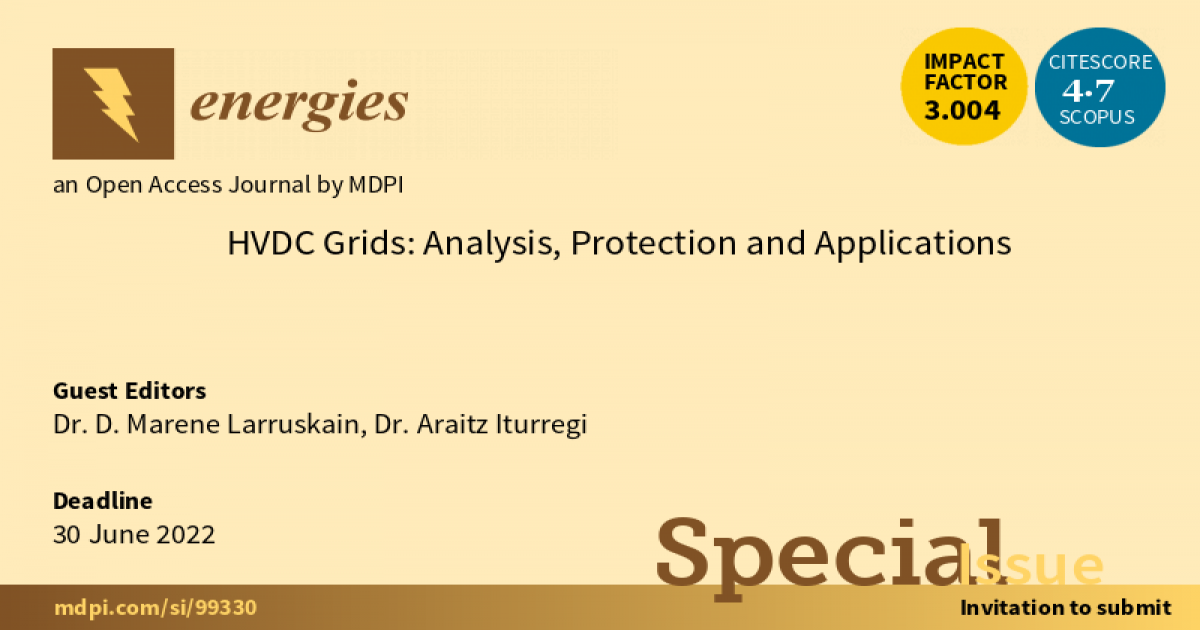HVDC Grids: Analysis, Protection and Applications
A special issue of Energies (ISSN 1996-1073). This special issue belongs to the section "A1: Smart Grids and Microgrids".
Deadline for manuscript submissions: closed (30 June 2022) | Viewed by 6171

Special Issue Editors
Interests: power system protection; renewable energy integration; HVDC systems
Special Issues, Collections and Topics in MDPI journals
Special Issue Information
Dear Colleagues,
At present, an efficient, interconnected, and resilient power system that deals with distinct and evolving challenges is required. HVDC grids are foreseen to reinforce the existing power system and to enable the integration of renewable resources on a bulk scale. Flexible HVDC technology can provide essential functionalities based on its inherent characteristics, such as fast power flow control capability.
This Special Issue is dedicated to HVDC grids. Therefore, we invite original papers addressing the various topics related to HVDC grids. The topics of interest include but are not limited to:
- HVDC system development, analysis, and design, including converter stations, MMC, DC–DC converters, semiconductor device developments, transmission links;
- DC-interconnected offshore wind power plants;
- Grid services, frequency support;
- HVDC grid control, including adaptive control, grid forming and grid following control;
- Stability analysis and harmonic interactions;
- Protection of HVDC grids, covering HVDC breaking devices, fault ride through, protection algorithms, protection schemes;
- Field experience with HVDC systems.
Dr. D. Marene Larruskain
Dr. Araitz Iturregi
Guest Editors
Manuscript Submission Information
Manuscripts should be submitted online at www.mdpi.com by registering and logging in to this website. Once you are registered, click here to go to the submission form. Manuscripts can be submitted until the deadline. All submissions that pass pre-check are peer-reviewed. Accepted papers will be published continuously in the journal (as soon as accepted) and will be listed together on the special issue website. Research articles, review articles as well as short communications are invited. For planned papers, a title and short abstract (about 250 words) can be sent to the Editorial Office for assessment.
Submitted manuscripts should not have been published previously, nor be under consideration for publication elsewhere (except conference proceedings papers). All manuscripts are thoroughly refereed through a single-blind peer-review process. A guide for authors and other relevant information for submission of manuscripts is available on the Instructions for Authors page. Energies is an international peer-reviewed open access semimonthly journal published by MDPI.
Please visit the Instructions for Authors page before submitting a manuscript. The Article Processing Charge (APC) for publication in this open access journal is 2600 CHF (Swiss Francs). Submitted papers should be well formatted and use good English. Authors may use MDPI's English editing service prior to publication or during author revisions.
Keywords
- HVDC equipment
- Converter
- Multi-terminal HVDC grid
- Wind power
- Control
- Stability
- Protection
- Protection algorithm
- HVDC circuit breaker
Benefits of Publishing in a Special Issue
- Ease of navigation: Grouping papers by topic helps scholars navigate broad scope journals more efficiently.
- Greater discoverability: Special Issues support the reach and impact of scientific research. Articles in Special Issues are more discoverable and cited more frequently.
- Expansion of research network: Special Issues facilitate connections among authors, fostering scientific collaborations.
- External promotion: Articles in Special Issues are often promoted through the journal's social media, increasing their visibility.
- Reprint: MDPI Books provides the opportunity to republish successful Special Issues in book format, both online and in print.
Further information on MDPI's Special Issue policies can be found here.





